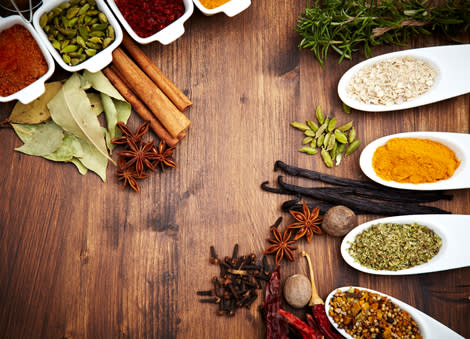Spice Things Up: Your Dishes and Health Will Thank You

As adapted from a blog by Jackie Lekerman
Home cooks tend to keep two or three spices in their pantry, but here you have a basic encyclopedia on some new spices you can add into your everyday repertoire to spice things up. It'll make a huge difference in your dishes, adding to overall flavor, scent and presentation, as well as giving you some added health benefits.
Make eating healthy fun for your kids
-Anise: Sweet and very fragrant, it's one of the oldest spices. The seeds are used in desserts and to infuse liquors and spirits. The leaves are excellent as an aromatic herb when used in meat dishes as well. Due to its particular composition, anise stimulates appetite and prevents the formation of gases. In tea, it's widely used to help relieve digestive issues in breastfed infants.
-Basil: Use only the leaves for cooking, fresh or dried. This herb is a staple in Mediterranean cuisine, and it is used to add flavor in dishes that include tomato and, of course, pesto sauce.
-Cardamom: This is one of the most expensive spices, along with saffron and vanilla; it's used to season bread, cakes, sweets, as well as curry.
-Capers: Capers are the buds of the caper bush, native to the Mediterranean region. The buds have are handpicked within the first three days they appear on the plant, which makes their harvesting quite labor-intensive and contributes to their high cost.
-Cayenne: Cayenne is a very common spice in Indian and Latin American cuisine, but because of its strong spicy flavor, it must be used cautiously. It stimulates blood flow and digestion, and it's a basic ingredient in Tabasco sauce.
Cool drink recipes for a hot summer
-Chives: The fresh leaves add flavor to mixed salads, stuffings, escabeches, salsa verde with mustard, tartar sauce, etc. They can also withstand being frozen.
-Cinnamon: A very aromatic spice, widely used in Eastern cuisine for centuries. In the West, it is mainly used in sweet dishes and baked goods, or to enhance flavor in hot beverages like chocolate or coffee.
-Coriander: The leaves and seeds of coriander have a different flavor, so it is both an aromatic herb and a spice. The seeds, whole and ground, can be used to make bread, cookies and other baked goods.
-Saffron: The most expensive spice in the world because of the labor-intensive process of drying, it's a key ingredient in fish and rice dishes of Spain.
-Turmeric: Part of the ginger family, Turmeric is native to the island of Java, although it is widespread in Asia, Central America and the Antilles. It's a dark yellow spice, frequently used in hindu dishes. Like ginger, it's also a remedy for stomach issues as it stimulates the secretion of gastric juice. It's also one of the main ingredients in powder curry and Worcestershire sauce.
